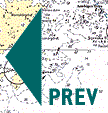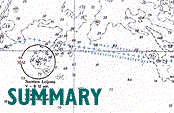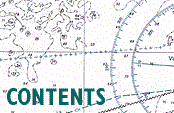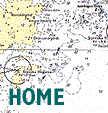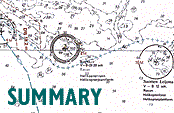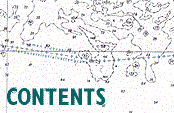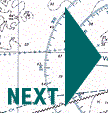CHAPTER 9 INTERNATIONAL CONVENTIONS, LEGISLATION, REGULATIONS AND CO-OPERATION |
9.1 International co-operation and conventions |
 |
Shipping is an international activity and co-operation to enhance safety and uniformity has long been in progress. Extensive international co-operation evolved, however, only after the United Nations' decision to create an Inter-Governmental Maritime Consultative Organisation (IMCO). The first working meeting of the Organisation was held in 1959.
 The authority of the Organisation was expanded in 1982 and its name was changed to the International Maritime Organisation (IMO). IMO has its permanent administrative office in London and consisted in September 1994 of 149 Member States. The authority of the Organisation was expanded in 1982 and its name was changed to the International Maritime Organisation (IMO). IMO has its permanent administrative office in London and consisted in September 1994 of 149 Member States.
 Heading the IMO is its Assembly, which meets once every second year. A Council normally meets twice each year. The Council acts as the IMO's governing body and consists of 32 elected Member States. The IMO is a technical organisation and most of its work is carried out in a number of committees and sub-committees. The structure of the Organisation is subject to changes as new demands arise. Heading the IMO is its Assembly, which meets once every second year. A Council normally meets twice each year. The Council acts as the IMO's governing body and consists of 32 elected Member States. The IMO is a technical organisation and most of its work is carried out in a number of committees and sub-committees. The structure of the Organisation is subject to changes as new demands arise.
 The Organisation's two most important technical bodies are the Maritime Safety Committee (MSC) and the Marine Environment Protection Committee (MEPC). The Organisation's two most important technical bodies are the Maritime Safety Committee (MSC) and the Marine Environment Protection Committee (MEPC).
 The MSC, which is responsible for all safety matters except marine pollution, has the following sub-committees with specific areas of expertise: The MSC, which is responsible for all safety matters except marine pollution, has the following sub-committees with specific areas of expertise:
- Ship Design and Equipment
- Stability and Load Lines and Fishing Vessels' Safety
- Fire Protection
- Safety of Navigation
- Bulk Liquid and Gases
- Dangerous Goods, Solid Cargoes and Containers
- Standards of Training and Watchkeeping
- Flag State Implementation
- Radio Communications and Search and Rescue
The work of the MSC is generally identified by its goal of fostering and enhancing several international conventions related to maritime safety. The result is reflected, inter alia, in the International Convention for the Safety of Life at Sea (SOLAS), the International Convention on Load Lines (ILLC), the International Convention on Standards of Training, Certification and Watchkeeping for Seafarers (STCW), the Convention on the International Regulations for Preventing Collisions at Sea (COLREG) and the International Convention on Tonnage Measurement of Ships.
 Conventions enter into force when they have been ratified either by a specified number of Contracting Governments, or Contracting Governments with a combined merchant tonnage constituting not less than a specified percentage of the gross tonnage of the world's merchant fleet. Conventions enter into force when they have been ratified either by a specified number of Contracting Governments, or Contracting Governments with a combined merchant tonnage constituting not less than a specified percentage of the gross tonnage of the world's merchant fleet.
 Most of the conventions are continuously under development as the work within the IMO progresses and is updated by Amendments, and as new issues need attention whenever deemed appropriate by Contracting Governments. Amendments to technical requirements and regulations enter into force automatically after a certain period and are binding on states which have ratified the Convention itself. A number of minimum performance standards, guidelines, interpretations and other recommendations are issued as Assembly Resolutions. These are recommended for implementation but are not binding on Member States unless explicitly referred to in the texts of the Conventions. Most of the conventions are continuously under development as the work within the IMO progresses and is updated by Amendments, and as new issues need attention whenever deemed appropriate by Contracting Governments. Amendments to technical requirements and regulations enter into force automatically after a certain period and are binding on states which have ratified the Convention itself. A number of minimum performance standards, guidelines, interpretations and other recommendations are issued as Assembly Resolutions. These are recommended for implementation but are not binding on Member States unless explicitly referred to in the texts of the Conventions.
 The 1960 solas convention, the first to be adopted under the auspices of the IMCO, entered into force in 1965. It replaced earlier conventions of 1914, 1929, and 1948. The present version was adopted in 1974 and entered into force in 1980. The Convention has been, and continues to be, modified and amended and two Protocols (1978 and 1988) have been adopted to respond to increased safety needs and to allow for technical development. Amendments made in 1988, known as “SOLAS 90” increased the requirements as to damage stability of new passenger ships and in 1992 similar requirements were extended to existing passenger ships. The 1960 solas convention, the first to be adopted under the auspices of the IMCO, entered into force in 1965. It replaced earlier conventions of 1914, 1929, and 1948. The present version was adopted in 1974 and entered into force in 1980. The Convention has been, and continues to be, modified and amended and two Protocols (1978 and 1988) have been adopted to respond to increased safety needs and to allow for technical development. Amendments made in 1988, known as “SOLAS 90” increased the requirements as to damage stability of new passenger ships and in 1992 similar requirements were extended to existing passenger ships.
 IMO Conventions do not generally have retroactive effect and the requirements applicable to a ship are therefore those which were in force at the time the ship was built. However, in recent years certain requirements have been made applicable retroactively for existing ships. IMO Conventions do not generally have retroactive effect and the requirements applicable to a ship are therefore those which were in force at the time the ship was built. However, in recent years certain requirements have been made applicable retroactively for existing ships.
 Problems related to the effective implementation and application of IMO's instruments by certain member states have been recognised by the Organisation and a special sub-committee on Flag State Implementation has been established to develop ways of ensuring compliance with the Conventions and other relevant instruments. Problems related to the effective implementation and application of IMO's instruments by certain member states have been recognised by the Organisation and a special sub-committee on Flag State Implementation has been established to develop ways of ensuring compliance with the Conventions and other relevant instruments.
 In response to the ESTONIA accident and upon the initiative of the Secretary-General of the IMO, a Panel of Experts was set up in December 1994, under the supervision of a Steering Committee, open to all Member Governments and international organisations concerned. The Panel's task was to review all safety aspects of ro-ro ships and advise the MSC of any action required (Chapter 19). In response to the ESTONIA accident and upon the initiative of the Secretary-General of the IMO, a Panel of Experts was set up in December 1994, under the supervision of a Steering Committee, open to all Member Governments and international organisations concerned. The Panel's task was to review all safety aspects of ro-ro ships and advise the MSC of any action required (Chapter 19).
 Telecommunication at sea is regulated by rules and regulations issued by another UN organisation, the International Telecommunication Union (ITU). This body co-ordinates the global telecommunication networks and services and is responsible for regulating the standards of all kinds of telecommunication. A committee within ITU deals with all matters related to radio communication, including allocation of frequencies and the technical properties of transmissions for maritime radio. It lays down performance standards for maritime radio equipment and also issues certificates for the personnel of ship stations and ship land stations. ITU publishes the International Radio Regulations and many maritime radio catalogues, e.g. the List of Coast Stations, the List of Ship Stations, the List of Radio Determination and Special Service Stations. Telecommunication at sea is regulated by rules and regulations issued by another UN organisation, the International Telecommunication Union (ITU). This body co-ordinates the global telecommunication networks and services and is responsible for regulating the standards of all kinds of telecommunication. A committee within ITU deals with all matters related to radio communication, including allocation of frequencies and the technical properties of transmissions for maritime radio. It lays down performance standards for maritime radio equipment and also issues certificates for the personnel of ship stations and ship land stations. ITU publishes the International Radio Regulations and many maritime radio catalogues, e.g. the List of Coast Stations, the List of Ship Stations, the List of Radio Determination and Special Service Stations.
 Another UN organisation, the International Labour Organisation (ILO), deals with certain matters relating to shipping, such as crew accommodation, working conditions and health. Another UN organisation, the International Labour Organisation (ILO), deals with certain matters relating to shipping, such as crew accommodation, working conditions and health.
 The Commission of the European Communities has also taken action to increase safety at sea, primarily by urging its Member States to be more active in IMO's work towards higher safety standards, requirements for increased port state control and other efforts made to reduce accidents related to human error. The Commission of the European Communities has also taken action to increase safety at sea, primarily by urging its Member States to be more active in IMO's work towards higher safety standards, requirements for increased port state control and other efforts made to reduce accidents related to human error.
 The Organisation for Economic Co-operation and Development (OECD) has expressed concern about safety at sea and has also stressed that ships must comply with international requirements. The use of sub-standard ships in transport is regarded as unacceptable from the point of view of economic equality since it leads to distortion of competition. The Organisation for Economic Co-operation and Development (OECD) has expressed concern about safety at sea and has also stressed that ships must comply with international requirements. The use of sub-standard ships in transport is regarded as unacceptable from the point of view of economic equality since it leads to distortion of competition.
 Regional co-operation between the states surrounding the Baltic Sea led to the Helsinki Convention for the Protection of the Marine Environment of the Baltic Sea Area, HELCOM 1974, which entered into force in 1982. The Convention is, however, insofar it addresses shipping, binding only upon ships flying the flags of the Baltic Sea states. IMO has issued a recommendation that the Convention should also be respected by ships of other nationalities. Regional co-operation between the states surrounding the Baltic Sea led to the Helsinki Convention for the Protection of the Marine Environment of the Baltic Sea Area, HELCOM 1974, which entered into force in 1982. The Convention is, however, insofar it addresses shipping, binding only upon ships flying the flags of the Baltic Sea states. IMO has issued a recommendation that the Convention should also be respected by ships of other nationalities.
 An agreement, the Paris Memorandum of Understanding (MOU) on Port State Control, which was concluded in 1980 by the Maritime Authorities of 14 European states, took effect in 1982. This agreement provides for port state control with a view to ensuring that, without discrimination as to flag, foreign merchant ships visiting the ports of a Member State comply with the standards laid down in the relevant instruments. The MOU requires, among other things, that a Member State achieves an annual total of inspections corresponding to 25 per cent of the estimated number of individual foreign merchant ships entering its ports during a 12-month period. Such inspection is primarily a visit on board to check the relevant certificates and documents and, in case of doubt, to carry out a more detailed inspection. An agreement, the Paris Memorandum of Understanding (MOU) on Port State Control, which was concluded in 1980 by the Maritime Authorities of 14 European states, took effect in 1982. This agreement provides for port state control with a view to ensuring that, without discrimination as to flag, foreign merchant ships visiting the ports of a Member State comply with the standards laid down in the relevant instruments. The MOU requires, among other things, that a Member State achieves an annual total of inspections corresponding to 25 per cent of the estimated number of individual foreign merchant ships entering its ports during a 12-month period. Such inspection is primarily a visit on board to check the relevant certificates and documents and, in case of doubt, to carry out a more detailed inspection.
 Similar agreements have subsequently been adopted in other regions as well. IMO's Assembly resolution A787(19) recommends inter alia that Member States also include operational checks on the competence of the crew during port state control inspections. Similar agreements have subsequently been adopted in other regions as well. IMO's Assembly resolution A787(19) recommends inter alia that Member States also include operational checks on the competence of the crew during port state control inspections.
|
 |
9.2 National maritime administration and legislation |
 |
The United Nations Conference on the Law of the Sea (UNCLOS) stipulates that the flag state has the main responsibility for enacting legislation to ensure the safety of its ships. States that have ratified a Convention are required to introduce the Convention's requirements into their own national legislation or to make equivalent arrangements. Some nations have added requirements over and above those of the Conventions. The general philosophy is, however, that the minimum requirements should be stringent enough for world-wide acceptance. A state's national regulations apply only to ships flying the flag of that state.
 Conventions normally permit the administration of a state to delegate certain functions, required by the Convention, to authorised organisations, usually classification societies. Nevertheless, the responsibility for ensuring the ships' compliance with Convention requirements remains entirely with the state administration on whose behalf the organisations act. Conventions normally permit the administration of a state to delegate certain functions, required by the Convention, to authorised organisations, usually classification societies. Nevertheless, the responsibility for ensuring the ships' compliance with Convention requirements remains entirely with the state administration on whose behalf the organisations act.
The Estonian administration
The Estonian National Maritime Board has four departments: General Department, Maritime Safety Department, Coast Guard Department (until 17 April 1995) and Lighthouse and Hydrography Department.
 The Maritime Safety Department consists of the Fleet Section and two sections with service functions, Ship Control Service and Pilot Service. The Maritime Safety Department consists of the Fleet Section and two sections with service functions, Ship Control Service and Pilot Service.
 The Ship Control Service, which was established in April 1994, consists of eight sections, Navigation and Communications Section, Technical Section and six Harbour Master Sections (five sections on the coast, and one on inland waterways). The Pilot Service is responsible for pilotage in the Estonian inland sea. The Ship Control Service, which was established in April 1994, consists of eight sections, Navigation and Communications Section, Technical Section and six Harbour Master Sections (five sections on the coast, and one on inland waterways). The Pilot Service is responsible for pilotage in the Estonian inland sea.
 The main tasks of the Coast Guard Department are the search for and rescue of humans at sea, the localisation and combating of pollution at sea, surveillance of the purposeful exploitation of Estonian waters and surveillance of ships' safety. The main tasks of the Coast Guard Department are the search for and rescue of humans at sea, the localisation and combating of pollution at sea, surveillance of the purposeful exploitation of Estonian waters and surveillance of ships' safety.
 The Fleet Section is responsible for the maintenance of the fleet of the Estonian National Maritime Administration. The Fleet Section is responsible for the maintenance of the fleet of the Estonian National Maritime Administration.
 The Maritime Board has authorised six classification societies, all members of IACS (on IACS see 9.3), to perform statutory surveys under the SOLAS, MARPOL, Load Line, Tonnage and ColReg Conventions and to issue the related certificates. The Maritime Board has authorised six classification societies, all members of IACS (on IACS see 9.3), to perform statutory surveys under the SOLAS, MARPOL, Load Line, Tonnage and ColReg Conventions and to issue the related certificates.
The Finnish administration
The Finnish Maritime Administration consists of the Head Office and four Maritime Districts. The Maritime Administration is an independent body reporting to the Ministry of Transport and Communications. The Head Office is divided into five departments, one of which is the Maritime Safety Department.
 The Maritime Safety Department supervises that ships are properly constructed, equipped, manned and operated. The department takes care of international co-operation related to ship safety and marine pollution. The Maritime Safety Department supervises that ships are properly constructed, equipped, manned and operated. The department takes care of international co-operation related to ship safety and marine pollution.
 The department is divided into the Ship Inspection Section and Ship Technical Section. The Inspection Section handles seafarers' competence, manning, lifesaving, navigation and radio matters. The Technical Section handles construction, stability, load line, fire safety, tonnage measurement, dangerous cargoes and pollution prevention matters. The department is manned by 35 persons. The department is divided into the Ship Inspection Section and Ship Technical Section. The Inspection Section handles seafarers' competence, manning, lifesaving, navigation and radio matters. The Technical Section handles construction, stability, load line, fire safety, tonnage measurement, dangerous cargoes and pollution prevention matters. The department is manned by 35 persons.
 There are 25 inspectors, organised in four districts, for surveys of Finnish flag vessels and for port state control of foreign ships. There are 25 inspectors, organised in four districts, for surveys of Finnish flag vessels and for port state control of foreign ships.
 Finland has authorised four classification societies, belonging to IACS, to carry out surveys for compliance with the SOLAS, MARPOL and Load Line conventions. Finland has authorised four classification societies, belonging to IACS, to carry out surveys for compliance with the SOLAS, MARPOL and Load Line conventions.
The Swedish administration
The Swedish Maritime Administration, with headquarters in Norrköping, is organised into six departments, one of which is the Maritime Safety Inspectorate.
 The Maritime Safety Inspectorate is headed by the Director of Maritime Safety, appointed by the Government. The Inspectorate has approximately 140 employees, of whom just under half work in the head office. The rest are divided between the regional Inspectorate Areas and the Rotterdam office. The Maritime Safety Inspectorate is headed by the Director of Maritime Safety, appointed by the Government. The Inspectorate has approximately 140 employees, of whom just under half work in the head office. The rest are divided between the regional Inspectorate Areas and the Rotterdam office.
 The Inspection Department at head office was at the time of the ESTONIA accident divided to four sections: the Ship Technical section, the Ship Operational section, the Investigating section and the Planning section. An international secretariat within the department handles international matters related to safety and marine pollution prevention, including co-ordination of Sweden's participation in the work of IMO. The organisation has subsequently been expanded with a pollution prevention section and a quality section. The Inspection Department at head office was at the time of the ESTONIA accident divided to four sections: the Ship Technical section, the Ship Operational section, the Investigating section and the Planning section. An international secretariat within the department handles international matters related to safety and marine pollution prevention, including co-ordination of Sweden's participation in the work of IMO. The organisation has subsequently been expanded with a pollution prevention section and a quality section.
 Inspection and related works have largely been delegated to the regional Inspectorate Areas. Inspection and related works have largely been delegated to the regional Inspectorate Areas.
 The Administration has authorised five classification societies, members of IACS, to perform surveys and inspections required by the SOLAS, Load Line and MARPOL Conventions. The right to issue the relevant certificates has in some cases been delegated to the classification society and in other cases been retained by the Administration. The Administration has authorised five classification societies, members of IACS, to perform surveys and inspections required by the SOLAS, Load Line and MARPOL Conventions. The right to issue the relevant certificates has in some cases been delegated to the classification society and in other cases been retained by the Administration.
 The master of the ship is required by law to report incidents on a standard form to the Marine Accident Investigation Section. The master of the ship is required by law to report incidents on a standard form to the Marine Accident Investigation Section.
|
 |
9.3 Classification societies |
 |
The first classification society was formed in the mid-18th century to give underwriters independent information about the condition of ships intended to be insured. Several other classification societies were formed at the beginning of the 19th century.
 The main purpose of a classification society is to perform neutral surveys and inspections. A classification society is engaged for a given ship by the shipowner from the design stage of the newbuilding, through the construction phase and subsequently throughout the life of the ship. A classification, carried out by a recognised society, is normally a requirement of insurance companies. A classification society's requirements, valid at the time of building a vessel, generally apply to the vessel throughout her life. Retroactive application of new requirements has not been practised although some movement in that direction has recently taken place. The main purpose of a classification society is to perform neutral surveys and inspections. A classification society is engaged for a given ship by the shipowner from the design stage of the newbuilding, through the construction phase and subsequently throughout the life of the ship. A classification, carried out by a recognised society, is normally a requirement of insurance companies. A classification society's requirements, valid at the time of building a vessel, generally apply to the vessel throughout her life. Retroactive application of new requirements has not been practised although some movement in that direction has recently taken place.
 Classification societies are generally organised as non-profit organisations and charge shipyards and shipowners for their services at cost. A classification society performs independent research into ship design and safety for the development of appropriate rules. Classification societies are generally organised as non-profit organisations and charge shipyards and shipowners for their services at cost. A classification society performs independent research into ship design and safety for the development of appropriate rules.
 Classification societies are also involved, depending on their resources, competence and world-wide coverage, in performing, on behalf of administrations, the statutory surveys required by the various international conventions. The arrangements are agreed between the national administration in question and the society and define the level of delegation and issuance of certificates. Classification societies are also involved, depending on their resources, competence and world-wide coverage, in performing, on behalf of administrations, the statutory surveys required by the various international conventions. The arrangements are agreed between the national administration in question and the society and define the level of delegation and issuance of certificates.
 The eleven major classification societies have a co-operative organisation, the International Association of Classification Societies (IACS), which co-ordinates the policy of the societies, co-ordinates exchange of experience and technical knowledge and issues unified recommendations for the standard to be applied in essential technical matters. Bureau Veritas is one of the members of IACS. Several other, national, classification societies exist which are not members of IACS and which do not qualify for such membership. The eleven major classification societies have a co-operative organisation, the International Association of Classification Societies (IACS), which co-ordinates the policy of the societies, co-ordinates exchange of experience and technical knowledge and issues unified recommendations for the standard to be applied in essential technical matters. Bureau Veritas is one of the members of IACS. Several other, national, classification societies exist which are not members of IACS and which do not qualify for such membership.
 Classification societies have from time to time and in particular at the beginning of the 1990s been criticised regarding the quality and integrity of their work. The IACS has therefore developed a quality assurance concept which all the member societies must comply with. Individual classification societies have also instituted extensive internal training and development of work procedures in order to increase the effectiveness of their work. Classification societies have from time to time and in particular at the beginning of the 1990s been criticised regarding the quality and integrity of their work. The IACS has therefore developed a quality assurance concept which all the member societies must comply with. Individual classification societies have also instituted extensive internal training and development of work procedures in order to increase the effectiveness of their work.
|
 |
9.4 The relationships between owner, shipyard, administration and class |
 |
Ships have traditionally been built in close co-operation between the owner, the shipyard, the flag administration and the classification society. Before a building contract is signed, an outline specification is developed by the owner or the yard or both parties together. After a contract has been agreed a detailed building specification is developed by the two parties in co-operation. This specification is sufficiently detailed to specify all essential features of the newbuilding, but is still flexible enough to allow the yard to find practical design solutions.
 The yard produces drawings for the newbuilding. Major drawings are examined by the classification society for compliance with its building requirements and - where applicable and based on authorisation - with international conventions. The owner has the right to examine all drawings in which he might have an interest. Revisions to the drawings are often made during this work which eventually results in drawings approved by the owner and the classification society. The yard produces drawings for the newbuilding. Major drawings are examined by the classification society for compliance with its building requirements and - where applicable and based on authorisation - with international conventions. The owner has the right to examine all drawings in which he might have an interest. Revisions to the drawings are often made during this work which eventually results in drawings approved by the owner and the classification society.
 Drawings specifying the safety and accommodation standard will also normally have to be approved by the flag state administration. Drawings specifying the safety and accommodation standard will also normally have to be approved by the flag state administration.
 The shipyard builds the ship according to the approved drawings. Due to the complexity of a large ship and the fact that often only one ship is to be built to the drawings, drawings for every detail are not in practice produced. Some details are therefore often left open to the workmanship of the yard and the inspection by the classification society and the owner. The shipyard builds the ship according to the approved drawings. Due to the complexity of a large ship and the fact that often only one ship is to be built to the drawings, drawings for every detail are not in practice produced. Some details are therefore often left open to the workmanship of the yard and the inspection by the classification society and the owner.
 Attendance by the classification society during the building normally also includes inspection of important subcontractors' products at their works. Inspection at the yard includes general visual inspection of all essential work for compliance with approved drawings and detailed inspection or non-destructive testing of items that may call for such attention. The surveyor at the yard is the representative of the classification society. The surveyor's task is to ascertain that the ship is built according to the rules but normally, however, he is not in a position to make detailed examination of every small section of the ship. The responsibility for adequate workmanship and compliance with the approved plans and drawings still remains with the shipyard. Attendance by the classification society during the building normally also includes inspection of important subcontractors' products at their works. Inspection at the yard includes general visual inspection of all essential work for compliance with approved drawings and detailed inspection or non-destructive testing of items that may call for such attention. The surveyor at the yard is the representative of the classification society. The surveyor's task is to ascertain that the ship is built according to the rules but normally, however, he is not in a position to make detailed examination of every small section of the ship. The responsibility for adequate workmanship and compliance with the approved plans and drawings still remains with the shipyard.
 The owner may have his own inspectors and will often have more inspection capacity on a particular newbuilding than the classification society has. The owner's inspectors will often perform detailed inspection of the workmanship and will also cover areas where the classification society has no specific requirements. The owner's inspection team often includes the captain and the chief engineer who are selected to become the master and the chief engineer of the ship when delivered. The owner may have his own inspectors and will often have more inspection capacity on a particular newbuilding than the classification society has. The owner's inspectors will often perform detailed inspection of the workmanship and will also cover areas where the classification society has no specific requirements. The owner's inspection team often includes the captain and the chief engineer who are selected to become the master and the chief engineer of the ship when delivered.
 When the ship is completed, sea trials take place in accordance with a programme agreed between the yard, the owner and the classification society. After successful trials and any required supplementary work, the ship is delivered to the owner. The yard will be closely related with the ship during a subsequent guarantee period, normally one year. When the ship is completed, sea trials take place in accordance with a programme agreed between the yard, the owner and the classification society. After successful trials and any required supplementary work, the ship is delivered to the owner. The yard will be closely related with the ship during a subsequent guarantee period, normally one year.
 The classification society will follow up the ship in accordance with its requirements and practice. The work is often divided into annual portions on a rolling time schedule of maximum five years. The annual surveys are made in conjunction with annual dockings of ships for which this frequency is required, or in conjunction with afloat underwater surveys of ships for which this procedure has been approved. The classification society will follow up the ship in accordance with its requirements and practice. The work is often divided into annual portions on a rolling time schedule of maximum five years. The annual surveys are made in conjunction with annual dockings of ships for which this frequency is required, or in conjunction with afloat underwater surveys of ships for which this procedure has been approved.
 The co-operation between the classification society and the owner is a commercial one, designed to assist the owner to obtain a ship of good class and to demonstrate during the life of the ship that the standard required by the rules is maintained. The co-operation between the classification society and the owner is a commercial one, designed to assist the owner to obtain a ship of good class and to demonstrate during the life of the ship that the standard required by the rules is maintained.
|
 |
9.5 The impact of the HERALD OF FREE ENTERPRISE accident on the development of safety regulations |
 |
In 1987, the ro-ro passenger ferry HERALD OF FREE ENTERPRISE capsized and foundered just outside Zeebrugge Harbour, Belgium, with heavy loss of life. The vessel had left the harbour with the bow doors open. When the ship increased speed, the bow wave exceeded the freeboard and water started to enter the lower vehicle deck through the open bow doors. In less than two minutes, at least 500 t of water had accumulated on the vehicle deck and the vessel capsized.
 Though ro-ro vessels had been lost prior to the HERALD OF FREE ENTERPRISE disaster, this accident drew renewed attention to the need for improving the safety of ro-ro vessels. Problems of the inadequate stability of such vessels when damaged had long been recognized, but the need for practical and efficient transport seems to have taken priority over safety considerations. Though ro-ro vessels had been lost prior to the HERALD OF FREE ENTERPRISE disaster, this accident drew renewed attention to the need for improving the safety of ro-ro vessels. Problems of the inadequate stability of such vessels when damaged had long been recognized, but the need for practical and efficient transport seems to have taken priority over safety considerations.
 The HERALD OF FREE ENTERPRISE accident triggered an intense world-wide discussion on all aspects of ro-ro safety. Improved damage stability standards for existing vessels were being proposed with the aim of introducing these internationally via the IMO network of convention requirements. The HERALD OF FREE ENTERPRISE accident triggered an intense world-wide discussion on all aspects of ro-ro safety. Improved damage stability standards for existing vessels were being proposed with the aim of introducing these internationally via the IMO network of convention requirements.
 In the discussion, the large, open vehicle space near the waterline was generally considered the main problem with regard to damage stability in the design of ro-ro ferries. If the external watertight integrity of the vehicle space is breached, unfavourable circumstances may initiate an ingress of water to the vehicle deck. Water is free to flow over the unsubdivided deck and large free surfaces are quickly formed, leading to the loss of stability and to list. In a heeled condition, the free surface is reduced and some stability is regained, but usually a small list is enough to immerse the car deck. Progressive flooding is likely to start and the list quickly develops to a capsize. In the discussion, the large, open vehicle space near the waterline was generally considered the main problem with regard to damage stability in the design of ro-ro ferries. If the external watertight integrity of the vehicle space is breached, unfavourable circumstances may initiate an ingress of water to the vehicle deck. Water is free to flow over the unsubdivided deck and large free surfaces are quickly formed, leading to the loss of stability and to list. In a heeled condition, the free surface is reduced and some stability is regained, but usually a small list is enough to immerse the car deck. Progressive flooding is likely to start and the list quickly develops to a capsize.
 The risk of collision was considered the most serious threat to the watertight integrity of the vehicle space though statistically ro-ro ships had been involved in few collisions. Numerous other possible ways of losing watertight integrity were listed including weather damage due to wave forces. The research was directed to generating data to support the development of new damage stability standards for ro-ro passenger ferries, but other subjects were also studied. As far as the Commission is aware, very little attention was paid to the wave impact forces on the bow doors and the strength of the locking devices. The risk of collision was considered the most serious threat to the watertight integrity of the vehicle space though statistically ro-ro ships had been involved in few collisions. Numerous other possible ways of losing watertight integrity were listed including weather damage due to wave forces. The research was directed to generating data to support the development of new damage stability standards for ro-ro passenger ferries, but other subjects were also studied. As far as the Commission is aware, very little attention was paid to the wave impact forces on the bow doors and the strength of the locking devices.
 One of the main items emerging from the discussions following the HERALD OF FREE ENTERPRISE accident was the very modest formal requirements for the damage stability of passenger ships in the final stage of flooding. A damaged ro-ro passenger vessel with a minimum freeboard and transverse residual metacentric height would be unlikely to survive in anything but calm conditions. This had already been demonstrated in the early seventies by damage stability model experiments, and was later confirmed in several extensive series of similar tests after the HERALD OF FREE ENTERPRISE accident. The new tests also indicated that even the residual stability criteria in SOLAS 90 would give sufficient protection against capsizing for a typical damaged ro-ro passenger vessel only in waves with a significant height of less than about 1.5 m. The chances of survival improved, in general, significantly with increasing residual freeboard and metacentric height. One of the main items emerging from the discussions following the HERALD OF FREE ENTERPRISE accident was the very modest formal requirements for the damage stability of passenger ships in the final stage of flooding. A damaged ro-ro passenger vessel with a minimum freeboard and transverse residual metacentric height would be unlikely to survive in anything but calm conditions. This had already been demonstrated in the early seventies by damage stability model experiments, and was later confirmed in several extensive series of similar tests after the HERALD OF FREE ENTERPRISE accident. The new tests also indicated that even the residual stability criteria in SOLAS 90 would give sufficient protection against capsizing for a typical damaged ro-ro passenger vessel only in waves with a significant height of less than about 1.5 m. The chances of survival improved, in general, significantly with increasing residual freeboard and metacentric height.
 Since a characteristic ro-ro passenger vessel sinking involves rapid heeling, the evacuation of large numbers of passengers from a high-sided jumbo ferry, perhaps in rough weather or at night, was considered a major problem. It was pointed out that “ro-ro ferries have no transition between survivable accidents and complete disaster”. The minimum requirement should be that a ferry during the flooding stage should stay sufficiently upright for sufficient time to give the passengers and crew a fair chance to evacuate. Since a characteristic ro-ro passenger vessel sinking involves rapid heeling, the evacuation of large numbers of passengers from a high-sided jumbo ferry, perhaps in rough weather or at night, was considered a major problem. It was pointed out that “ro-ro ferries have no transition between survivable accidents and complete disaster”. The minimum requirement should be that a ferry during the flooding stage should stay sufficiently upright for sufficient time to give the passengers and crew a fair chance to evacuate.
 Many devices including different sponsons and movable, partial bulkheads on the vehicle deck were developed and tested in model experiments to improve the damage survivability of existing ro-ro passenger vessels, but none of these devices obtained general acceptance. Many devices including different sponsons and movable, partial bulkheads on the vehicle deck were developed and tested in model experiments to improve the damage survivability of existing ro-ro passenger vessels, but none of these devices obtained general acceptance.
 |
 |
